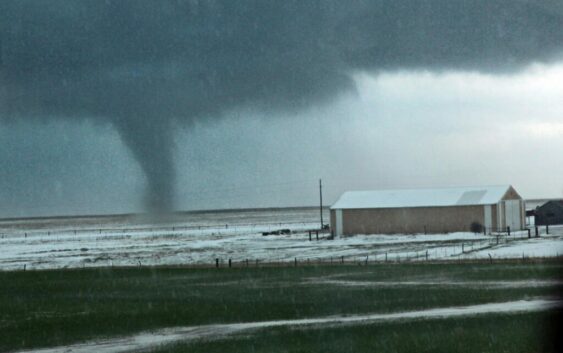- Hurricane Helene's name retired after deadly 2024 impact on US
- NC burn ban lifted statewide as rain improves wildfire conditions
- Western NC wildfire risk will 'get worse, not better' Ag Commissioner says, pressing lawmakers for help
- Watering trees is a must to protect them from severe weather and drought
- At least 4 dead, hundreds rescued after deadly floods ravage South Texas
‘They love seeing the majesty of these storms’: How tornado tourism has taken off

When there’s a tornado nearby, most people seek shelter. But there are also those who do quite the opposite.
Storm chasers live to get an up-close look at tornadoes and thunderstorms. And now, some of them are taking along other folks who want to get the same thrill – for a price.
Elizabeth Weise, a national correspondent for USA Today, recently reported on how storm-chasing tours in the U.S. have been gaining popularity. She joined the Standard with more.
This transcript has been edited lightly for clarity:
Texas Standard: You call this “tornado tourism” in a story you wrote about these storm-chasing companies that take people along for the ride. Before we get to the liability issues, what’s the big appeal here for people who want to do this?
Elizabeth Weise: You know, most of the people that I talked to, they love seeing the majesty of these storms. Many of them are photographers, but they want to do it in a safe and semi-controlled environment – you know, not the guys in their pickup truck heading straight into the storm. They want someone else driving who knows what they’re doing, and then they’re in the back taking pictures.
Well, the guys in the pickup trucks, that’s pretty much all I’m familiar with. What are these other organizations that have set up to do this kind of tornado tourism, and what makes them more safe than the pickup truck?
There’s maybe 12 to 15 companies like this in the States. It’s usually a small number of operators. They’ve usually got a lot of weather background; some of them even are meteorologists.
They have maybe two, or at most three, vans. So it’s a small group, generally not more than 20 people. And they figure out where are you going to go the next day to find a good storm.
They drive hundreds of miles a day, and then their guests get out and they kind of set up and they wait for the storm to appear. And they try and stay 2 or 3 miles away, partly for safety and partly because you get these amazing photos of these huge storm cells.
» GET MORE NEWS FROM AROUND THE STATE: Sign up for Texas Standard’s weekly newsletters
How much does it cost to put your life at risk chasing tornadoes?
These tours typically run between six and 11 days. It’s between $2,000 and $4,500, depending on how long, how luxurious, how many people there are on the trip. So it is not a cheap weekend away.
And I suppose you also have to sign a waiver or two.
Oh, so very, very many.
Certainly in any storm there are factors that you can’t foresee. I mean, Houston couldn’t foresee the derecho that hit them. And so even meteorologists with a lot of experience find the unpredictability to be, you know, beyond a wildcard.
So I guess I wonder: How safe is this, ultimately? I guess I’m thinking, should I try this out with my camera, too, or are the risks just too high?
Well, I have to say, we could not find examples of anyone getting killed on one of these storm-chasing tours. And there are many fewer storm-chasing tours than there are storm chasers out there. So we should say that up front.
I talked to a guy who’s a professor of tourism down in Florida, and he said, the whole thing about adventure tourism is you want to make it seem as on the edge as possible while making it as risk-free as possible. So, you know, they do safety drills, like this is how you get in and out of the van – red light means get in the van; this absolute second green light means you’ve got time to put your tripod away.
The guys who are leading them know they always have a plan B, another route out, should something go wrong. So even [the National Oceanic and Atmospheric Administration] says – because NOAA’s pretty clear, you shouldn’t be out there chasing storms – but even they say on their page about this, if you’re going to do it, do it with a tour because you’ve got seasoned professionals.
I understand a good number of the customers are actually from outside the United States. Why is that?
Yeah, that was fascinating. So I talked to this guy, Christoffer Björkwall, who’s a Swede who actually runs a website about this, and a couple of other people. You know, this kind of weather really only exists in the U.S.
I mean, there are tornadoes elsewhere, but we’ve got amazing weather. We’ve got a fantastic system of freeways and roadways, so you can kind of get to everything. We’ve got a really strong weather and radar network that our people have access to. And as you know, in Texas, we have these endless vistas.
And I mean, one of the guys from Germany said, “even if we had those things, they’d never let you do it in Germany.” Here, we do.